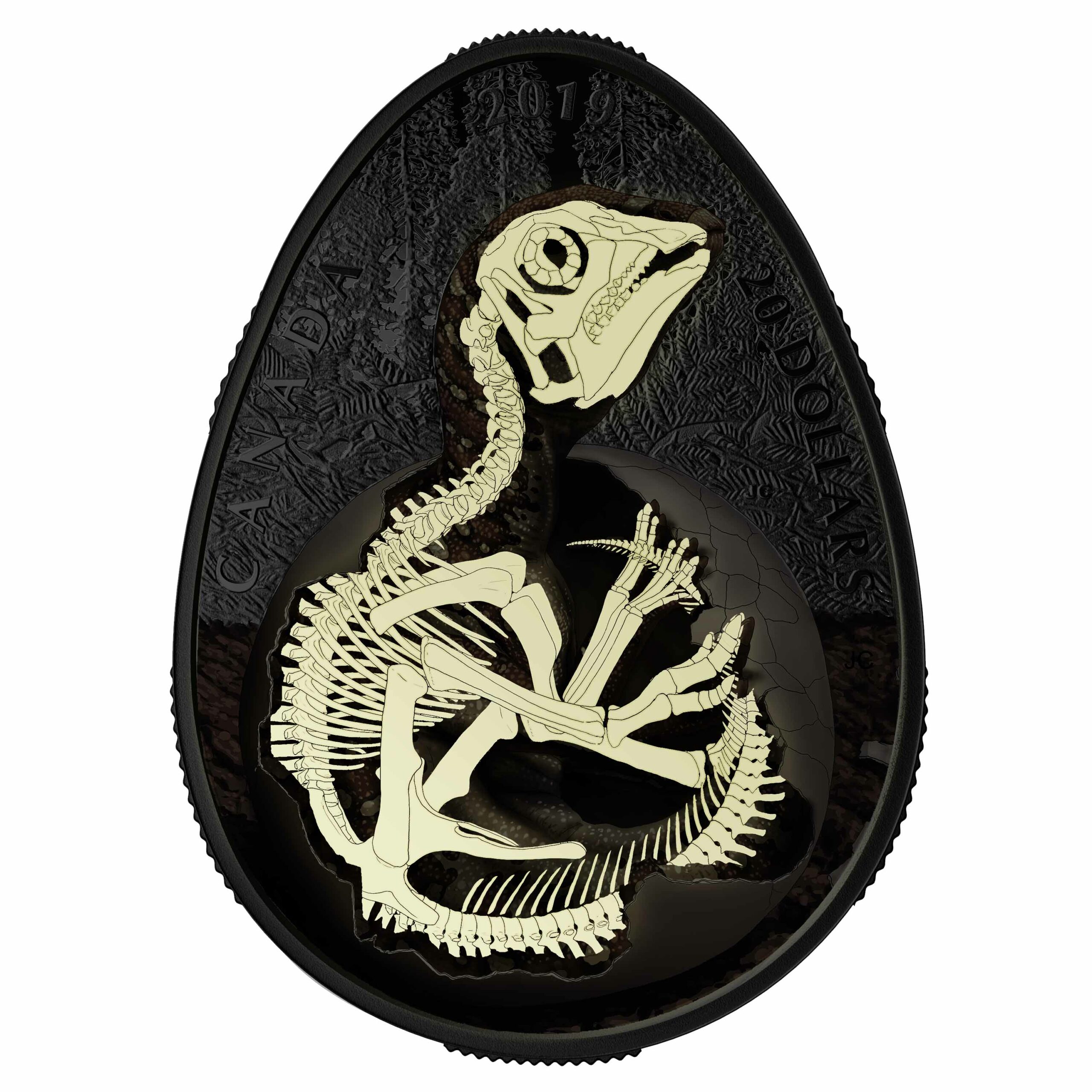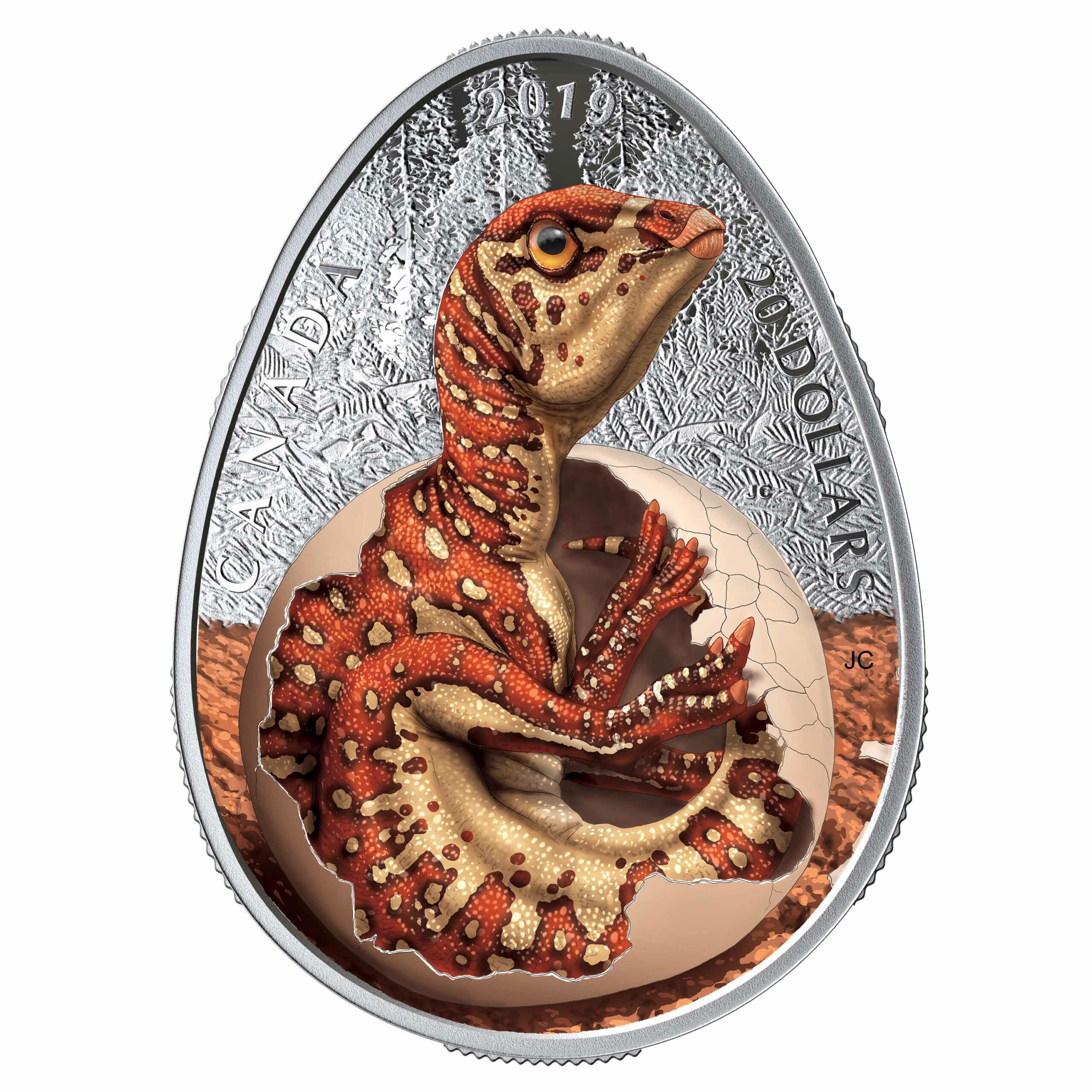2019 Canada Hatchling Hadrosaur Egg-Shaped Glow-in-the-Dark 1 oz Silver Coin
$139.95
Item specifics
| Year of Issue: | 2019 |
| Issuing Country: | Canada |
| Denomination: | $20 |
| Weight: | 1 oz |
| Composition: | .9999 Silver |
| Finish: | Colorized, Glow-in-the-Dark, Proof |
| Mintage: | 4,000 |
| Diameter: | 45 x 33 mm |
| Packaging: | Display Box w/COA |
There are few places in the world where dinosaur embryos have been discovered, but Canada is one of them. In 1987, eggshells found at Devil’s Coulee, in southern Alberta, led to the discovery of one of the largest dinosaur nesting sites in North America. There, palaeontologists from the Royal Tyrrell Museum unearthed the fossilized remains of Hypacrosaurus stebingeri nests, eggs, even embryos—a rare find for a species that roamed the land 75 million years ago. A young duckbill dinosaur emerges into a new world—ours—on our latest prehistoric-themed offering. The fine silver coin is the perfect shape for a colourful depiction of a baby Hypacrosaurus breaking free from its egg against an engraved forest backdrop.
A glow-in-the-dark dinosaur coin, perfect for fans of all ages! Order today!
- A FIRST! Your coin’s egg-like shape is the perfect fit for a dinosaur egg theme, and is our first egg-shaped dinosaur coin!
- A HIDDEN GLOW-IN-THE-DARK IMAGE! When activated, glow-in-the-dark technology reveals a hidden image: the skeleton of the young Hypacrosaurus stebingeri.
- REVIEWED FOR SCIENTIFIC ACCURACY! The design has been expertly reviewed by Alberta’s Royal Tyrrell Museum of Paleontology. In addition, your coin highlights the 1987 discovery of one of North America’s largest dinosaur nesting sites.
- NO NEED TO REMOVE IT FROM ITS CAPSULE! The glow-in-the-dark technology can be activated through the capsule.
- INCLUDES SERIALIZED CERTIFICATE! The Royal Canadian Mint certifies all of its collector coins.
- LIMITED MINTAGE: Only 4,000 coins will be made available worldwide.
- ONE OUNCE 99.99% PURE SILVER COIN! NO GST/HST!
Designed by Julius T. Csotonyi, your coin has been reviewed for scientific accuracy by palaeontologists at the Royal Tyrrell Museum of Palaeontology in Drumheller, Alberta. It features a coloured rendering of a young Hypacrosaurus stebingeri, as it may have appeared 75 million years ago. The hatchling emerges from its egg against an engraved prehistoric landscape of evergreens, conifers, shrubs and low plants. The Hypacrosaurus’ uniquely shaped beak is viewed in right side profile as the hatchling looks up; it does not yet have the bony crest that is a distinctive feature of the adult Hypacrosaurus. Glow-in-the-dark technology reveals fossilized remains that are based on those uncovered at Devil’s Coulee in southern Alberta.
- A Hypacrosaurus hatchling measured about a metre long. But by the age of 10, its full adult size was 10 metres long. They had to outgrow predators such as tyrannosaurids and dromaeosaurs in order to survive.
- Hypacrosaurus may have returned to the same area over time to nest, where it would deposit about 26 eggs in a single nest. Each egg was approximately 20 centimetres in diameter, or roughly the size of a volleyball!
- Similar to the nests of modern crocodiles, Hypacrosaurus eggs would have been buried under a mound of vegetation for incubation. Decomposition of the plant matter would have produced the heat required to incubate the eggs, since parents were too large to sit on the eggs like modern birds do.
- The adult Hypacrosaurus had a hollow crest on top of its head. This bony feature was connected to its airways to amplify its call, so others could hear it from far away.
- These plant-eaters had thousands of teeth, with new ones replacing older ones as they wore down.
- The Hypacrosaurus belongs to the hadrosaur family, dubbed the “duck-billed dinosaurs,” which were one of the most common dinosaurs to roam North America during the Late Cretaceous period.
Your coin is encapsulated and presented in a Royal Canadian Mint-branded maroon clamshell with a black beauty box.




